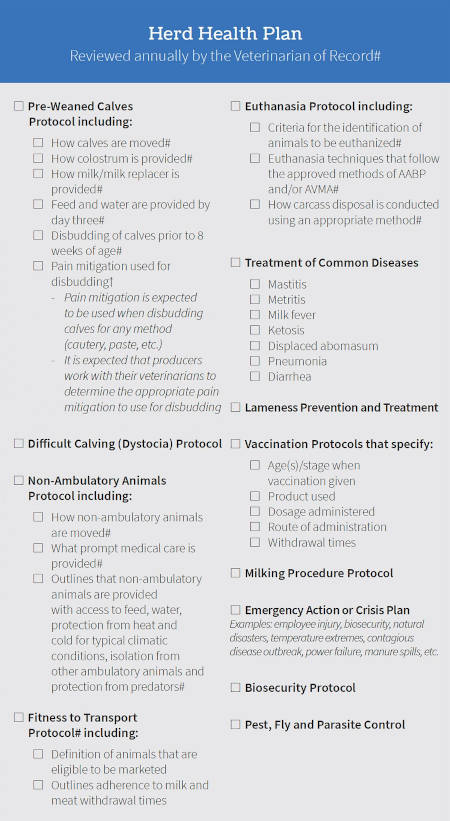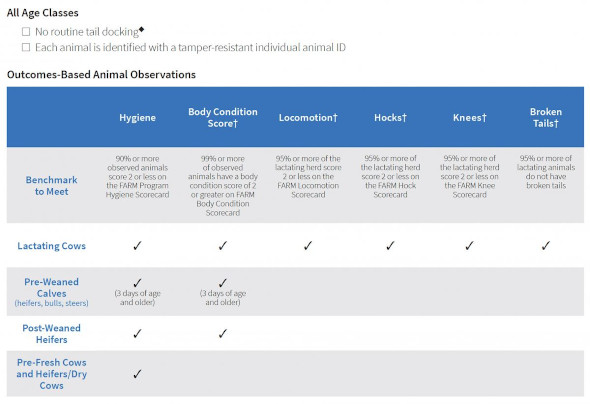By Heidi Carroll and Kimberly Clark
The FARM Animal Care Version 4.0 rolled out January 2020. This article is a condensed tool to aid you in preparing for your next evaluation. A detailed preparation guide that includes a checklist is located at the
National Dairy FARM webpage.We encourage you to reach out to your co-op or processor with questions or concerns as you prepare for your next evaluation. It is the responsibility of the FARM Evaluator to clearly communicate program expectations to the producer and schedule future evaluations. The “Documentation” section of this article provides a list of the records and protocols needed for the evaluation with a brief description of each. The “Observation” section outlines observations the evaluator will make while conducting the evaluation including which class of animals are observed for each criteria.
Documentation
Documents can be electronic or hard copy. However, all documents must be available at the farm and certain items must be posted to meet the criteria. For example, standard operating procedures (SOPs) should be posted in the appropriate area the tasks are being performed as a quick reference for employees. Consider the first languages of all employees and provide translated documents.
Google Translate is a resource to generate a translated draft of existing documents. Work with experienced translators or industry professionals to finalize the documents and ensure accurate translations.
- A cow care agreement needs to be signed by non-immediate family and immediate family members 18 years of older.
- Non-family labor: Each employee that is 18 years of age or older needs to have a signed animal care agreement
- Family labor: Each family member 18 years of age or older needs to sign the agreement ORif a family representative prefers to take the responsibility for all family members 18 years or older, they can sign a cow care agreement document for the immediate family. Immediate family members are grandparents, parents, in-laws, partners, siblings, children or grandchildren or legal owners of the dairy operation.
- A Veterinarian Client Patient Relationship (VCPR) form needs to be signed annually by the veterinarian of record.
- Annual continuing education/training needs to be provided and documented for employees (non-family and family) in their respective area(s) of animal care. Continuing education can be formal or informal taking the form of online videos, hands-on training, workshops, etc. Documentation of continuing education needs to be provided in the following areas.
- Stockmanship
- Pre-weaned calves
- Non-ambulatory animals
- Euthanasia
- Fit for transport

Figure 1. Herd health plan checklist. Courtesy: FARM
- Animal treatment records need to be maintained. These records can be written or electronic but must be available for review by an evaluator. If records are solely electronic, ensure employees performing animal care tasks have access to the records to keep them updated. Provide clear instructions on how records should be entered, so information remains consistent. These records should include:
- Date of treatment
- Animal treated identification
- Name of treatment product used
- Disease or condition treated
- Dosage administered
- Route of administration
- Duration of treatment
- Specific milk and meat withdrawal times.
- The herd health plan should be reviewed annually by the veterinarian of record and the review documented (date and initials of review need to be noted on the document). The herd health plan needs to include the following written protocols: (Additional criteria for each area is found in the Figure 1).
- Pre-weaned calves
- Difficult calving/dystocia
- Non-ambulatory animals
- Fitness to transport
- Euthanasia
- Treatment of common diseases
- Lameness prevention and treatment
- Vaccination
- Milking procedure
- Emergency action or crisis plan
- Biosecurity
- Pest, fly and parasite control
Observations

Figure 2. Animal measures summary. Courtesy: FARM
- Posted emergency contact information
- Clean, soft, dry, well-lit and well-ventilated calving area
- All facilities provide proper ventilation to reduce odors, dust, and/or noxious gas
- Method of daily exercise for all age classes
- Protection from heat and cold for typical climatic condition
- Housing allows all age classes of animals to easily stand up, lie down, adopt normal resting postures and have visual contact with other cattle without risk of injury
- Resting area for all age classes of animals that is clean, dry, provides traction at all times when away from the milking facility and does not pose risk of injury
- Facilities designed to prevent injuries, slips and falls of animals
- Facilities are designed to prevent unnecessary contact with electrical currents
- All age classes of animals have access to clean water and sufficient feed
- Animal measures will be observed and compared to the benchmark stated in Figure 2. Figure 2 summarizes the observations by the evaluator and indicates the expectation for tail docking and animal identification. Lactating cows are scored on all six observations - hygiene, body condition score, locomotion, hocks, knees, and broken tails, while pre-weaned and post-weaned calves are scored on hygiene and body condition score. Pre-fresh cows and heifers/dry cows are solely scored on hygiene.
Source : sdstate.edu